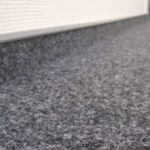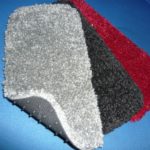The soft flooring gives the interior a homey feel. Carpet laying quickly solves the problem of thermal insulation and soundproofing of the floor. Universal material is suitable for an apartment and a country house. It is possible to lay a roll covering on any base - concrete screed, wood, linoleum. Having studied the methods of installation, they do the work with their own hands, saving on the services of masters.
Carpet selection
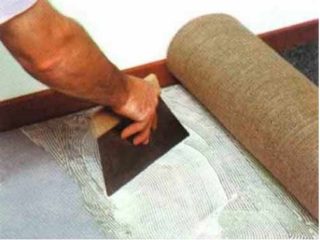
Choosing a floor covering is based on its practicality and decorative appeal. The carpet has a three-layer structure: the pile, the primary base for fixing it, the backing that enhances the wear resistance. The requirements for the product depend on the type of room in which it will be laid. The performance of the carpet depends on the method of production and dyeing, type and height of the pile.
Material
The quality and cost of the coating depends on the type of material from which the pile is made. All products can be divided into two main groups: natural and synthetic.
Natural fibers:
- Wool - soft and warm pile, consisting of one wool, is expensive, so it is partially replaced with synthetics. The percentage of natural fibers must be at least 10%.
- Cotton is a hygroscopic material that retains its original color for a long time. The downside is the quick wear of the threads.
- Linen is a durable fiber that resists wear and tear and dirt. The canvas is durable, does not cause an allergic reaction.
- Silk - is the basis of products or serves as an additive to wool. The products are light, beautiful, not afraid of deformation. The disadvantage is the high cost.
Natural pile quickly regains its shape after creases, it is pleasant to the touch. Wool is the most popular carpet material, but its pure use is impractical and dangerous. The fibers are subjected to anti-static, fire-prevention and anti-allergenic treatment.
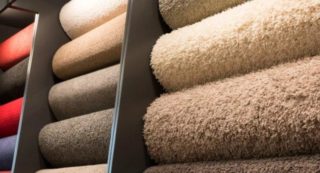
Synthetic fibers:
- Acrylic is an inexpensive option that is determined by its characteristic gloss and hardness. The service life is up to 10 years, it is inexpensive.
- Nylon - easy to care for, does not fade, lasts 10-15 years. The fibers are strong, moderately soft.
- Polypropylene is a budget type of coating that does not fade in the sun, is easy to clean, and does not accumulate static stress. Differs in softness, attractive appearance. The disadvantage is low wear resistance and thermal insulation.
The advantage of synthetic products is resistance to moisture, insects and mold. They have a bright variety of colors, are hypoallergenic, and are cheaper.
The base of the carpet is made of natural and artificial jute, rubber, latex or felt.
Appointment
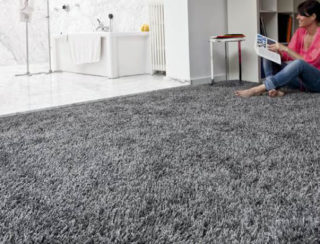
Carpet flooring is available for residential and commercial premises. According to the level of permissible load, it is divided into 3 classes:
- low;
- medium;
- high.
When choosing a product by type of room, the following factors are taken into account:
- Office - products on a rubberized basis with a short nap are suitable. They must be resistant to deformation, pollution, have a stable, dark coloration.
- Corridor, stairs, entrance hall - in residential areas with high traffic, a synthetic covering with a short pile is recommended.
- Bedroom - the best option for a long-pile carpet made of natural yarn. Light shades are acceptable.
- Children's room - basic requirements: safety and easy care. Synthetic products that do not cause allergies in children are suitable. The pile length is medium, bright colors are preferred.
A wide range of floor coverings allows you to find the option that best suits the type of room.
The main disadvantage of carpet is the difficulty in cleaning. It is difficult to remove stains and stubborn dirt from it. Over time, you will have to think about replacing the coating. Putting linoleum on an old carpet is permissible if the coating is strong enough. The material will serve as an insulating substrate. Laminate panels are also compatible with soft backing. The main requirement is a flat surface without height differences.
Manufacturing method
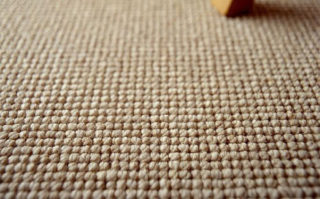
There are several technologies for the production of a soft coating:
- Woven - the basis of the method is the interweaving of the pile with the threads of the jute base. The result is a durable but expensive coating.
- Needle-punched - a fibrous blank is connected to the base by piercing with special needles. Rubber is glued on the seamy side of the product. The result is a lint-free wear-resistant fabric. One of the advantages is low cost. In this way, commercial flooring is produced.
- Tufted - a feature of the technology is the use of fibers of various sizes, which allows you to form a relief pattern. They are fixed to the base with latex and a second base. The top layer is looped and sheared. Products are durable due to a solid base.
- Flocked - a coating on a waterproof vinyl backing with a short pile. The layers are connected using electrostatic action. Flocking allows you to create an imitation of various textures on the canvas.
The manufacturing method affects the strength and durability of the material. Woven carpet is more pleasant to tactile and more reliable in use than other options.
Thread dyeing method
The dyeing technology affects the color retention during operation. A quality coating is made of colored threads. Fibers do not lose their brightness after dry cleaning or exposure to sunlight. Budget materials are dyed ready-made. This is an unreliable option, the pattern is quickly erased, fades unevenly. On such canvases, the base is initially poorly colored.
Pile shape and height
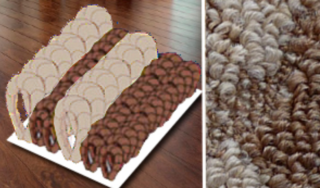
The appearance of the coating is determined by the pile. It comes in various lengths, shapes and densities, with split and solid loops. Weaving methods:
- Saxony - a web of twisted yarn with a split pile, has a grainy appearance.
- Velor - the ends of a short pile are fluffed, giving the product softness and volume.
- Shag - threads of medium length form a non-uniform tangled surface.
- Scroll - multi-level pile with trimmed and uncut loops creates a structural pattern.
- Frize - the yarn is twisted into rings and firmly fixed by the action of high temperature. The material is resistant to wear and tear.
- Cut-loop is a multi-level combination of cut and whole loops, the covering is embossed and soft.
- Boucle is a durable fabric made of threads tied in a knot "with an eye".
The density and stability of a carpet with whole loops is higher than that of a split pile.
Pile height:
- short - 2-5 mm, easy to clean, easy to clean, spreads in rooms with high stress;
- medium - 5-10 mm, a universal option, suitable for the living room and nursery;
- long - 10-40 mm and more, gives pleasant tactile sensations of warmth and softness, recommended for the bedroom.
Products are marked in the form of two numbers, indicating the purpose of the type of room and permissible load.High-pile material is laid in rooms with low traffic.
Coverage calculation rules
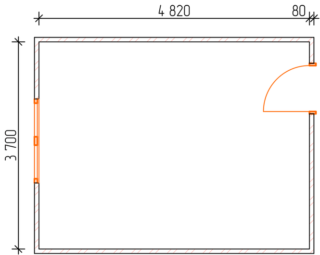
Before you put carpet in the room, you need to calculate the material.
You will need to measure the floor in the room and draw up a diagram. All openings, partitions, niches are marked on it. 5-10 cm of stock is added to the size of the room.
The material is sold in rolls of various widths. This parameter is chosen as close as possible to one of the dimensions of the room, because the canvas is cut only to length.
If the carpet is patterned, the stock is made according to the size of the rapport.
Base preparation technology
Installation of carpet requires preparation of the base, it must be clean and even. The nuances of the work depend on the floor material.
Concrete
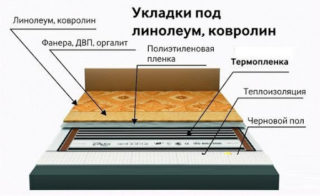
Before you start laying carpet on concrete, you need to check the condition of the screed. The cracks are sealed with a cement-sand mortar, the protrusions are knocked down. With significant differences in height, the base is repaired with a self-leveling screed. Any dirt - dust, greasy stains - is removed from the floor. The surface is treated with a primer solution. The procedure will prevent the permanent formation of dust. Loose or adhesive laying is recommended.
Wooden
Laying carpet on a wooden floor begins with examining the boards. A strong base is enough to loop and wash. The protruding heads of the nails are sunk into the wood. If the base has slots, it is better to sew it up with sheets of chipboard or moisture-resistant plywood. Plates are stacked with an offset, fixed with self-tapping screws. Before installing the coating, the wooden base is treated with primer.
Required tools and materials:
- roulette;
- carpet knife;
- glue roller;
- Double-sided tape;
- scissors;
- putty knife.
The range of tools and consumables varies depending on the chosen method of installing the flooring.
Carpet laying methods
Installation work is carried out in four ways. The choice of installation method depends on the size of the room, the base material, and the characteristics of the carpet.
Free
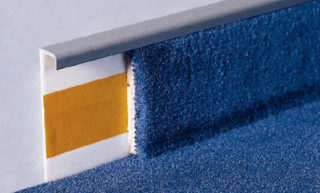
In a room up to 20 sq. m, free or floating laying is permissible. The covering is fixed only with a skirting board along the perimeter. Suitable for solid sheets.
Glue
One way to secure the carpet to the floor is with glue fixing. Recommended for large rooms and rooms with high traffic. The roll is rolled out on the floor, then folded in half. A special glue is applied to the freed base, the carpet is pressed against it, it is well smoothed. Do the same with the second part of the coating.
On scotch tape
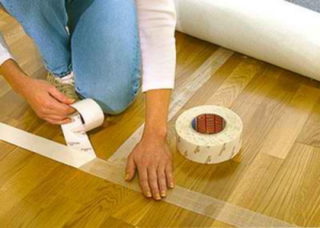
Double-sided tape is glued to a clean base - along the entire perimeter and in squares with a side of 50 cm over the area of the room. The upper protective strip is not removable. The carpet is spread with an approach to the walls by 8-10 cm. The canvas is adjusted to the size, then rolled into a roll. The protective film is gradually removed and the coating is rolled out. The carpet is tightly pressed against the base. It is convenient to work with two people, so that fixation occurs simultaneously across the entire width of the roll.
Stretching
The method requires the installation of grips to keep the carpet taut. The method is distinguished by reliable fixation and absence of irregularities. Wooden slats are installed around the perimeter. Previously, nails were driven into them at an angle of 45 °. The carpet is spread across the floor and, using a tool, is pulled onto the slats in all directions. Excess canvas is cut off.
DIY styling
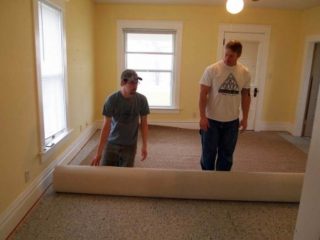
In rooms of a small area, free styling is performed or attached to adhesive tape around the perimeter. In spacious rooms, it is better to choose a more laborious but reliable option - gluing to the base. The material is brought into the room in a day. He must lie down in an unfolded state.Work begins at room temperature 18-22 ° C and humidity up to 60%.
Carpet laying on glue:
- The canvas is spread on the prepared base.
- In a day, half of the material is bent. Glue is applied to the base. A polyurethane or acrylic compound, PVA is recommended. The mixture is spread with a spatula and left for 10 minutes.
- The canvas is folded onto the floor, carefully leveled from the middle to the edges. You can roll it with a special roller.
- Then the second part of the cover is folded back and the procedure is repeated.
- Near the walls, the material is pressed tightly and cut off.
- A plinth is installed around the perimeter.
Carpet laying does not require professional skills and tools. If you wish, you can carry out the installation yourself, making the apartment more comfortable and warm.

